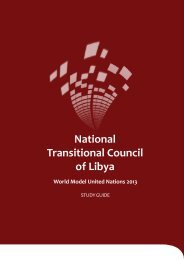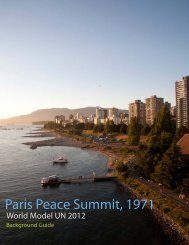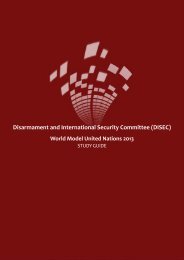Social, Humanitarian and Cultural Committee (SOCHUM)
Social, Humanitarian and Cultural Committee (SOCHUM)
Social, Humanitarian and Cultural Committee (SOCHUM)
Create successful ePaper yourself
Turn your PDF publications into a flip-book with our unique Google optimized e-Paper software.
years, she has used records from the 17 th century to<br />
write a dictionary, develop educational materials,<br />
<strong>and</strong> run adult language classes. 98 this example shows<br />
that language reclamation is possible with significant<br />
effort <strong>and</strong> also underscores the importance of<br />
creating an orthography <strong>and</strong> maintaining written<br />
documentation of endangered languages, in case<br />
they do become extinct.<br />
Past international Action<br />
The issue of language endangerment first caught<br />
the attention of the international community in<br />
the early 1990s with the 15th international Congress<br />
of Linguists in 1992. The gathering of linguistic<br />
experts from around the world to discuss the fate of<br />
endangered languages marked the first time that this<br />
problem had been the topic of a major international<br />
gathering. The final report of the 15th international<br />
Congress of Linguists called upon the United Nations<br />
Educational, Scientific <strong>and</strong> <strong>Cultural</strong> Organization<br />
(UNESCO), a specialized agency of the UN, to initiate<br />
a documentation campaign to record the grammars,<br />
texts, <strong>and</strong> oral histories of the endangered languages<br />
of the world. 99 uNeSCO did, in fact, respond to the<br />
appeal from the International Congress of Linguists,<br />
<strong>and</strong> the following year, the organization officially<br />
made endangered languages one of its priority issues<br />
<strong>and</strong> founded the Red Book of Endangered Languages,<br />
a compilation of information on the thous<strong>and</strong>s of<br />
endangered <strong>and</strong> dying languages across the globe.<br />
The International Clearing House of Endangered<br />
Languages was founded at the University of Tokyo<br />
in 1995 to coordinate the research <strong>and</strong> publication of<br />
the Red Book. the Red Book has since been replaced<br />
by the Atlas of the World’s Languages in Danger, which<br />
continues to be published to this day. 100<br />
Outside of this action by UNESCO, however, the<br />
United Nations has been rather silent on the issue of<br />
endangered languages. uNeSCO has assisted local<br />
activists <strong>and</strong> organizations in efforts to revitalize<br />
endangered languages, but it has not made any<br />
meaning for declarations of what must be done to<br />
secure the futures of dying languages. Most of the<br />
relevant UN resolutions on the topic have been about<br />
minority rights or cultural diversity more generally,<br />
<strong>and</strong> not specifically about endangered languages. In<br />
1992, the General Assembly passed the Declaration<br />
on the Rights of Persons Belonging to National or<br />
Ethnic, Religious <strong>and</strong> Linguistic Minorities. The first<br />
article of this resolution declares that “states shall<br />
protect the…linguistic identity…of minorities within<br />
their respective territories.” 101 Articles Two <strong>and</strong> Four<br />
go on to assert the rights of indigenous language<br />
speakers to learn their mother tongue, use it in the<br />
public <strong>and</strong> private sphere without discrimination, <strong>and</strong><br />
receive education in the language. 102 the Action Plan<br />
of the 2001 UNESCO Universal Declaration on <strong>Cultural</strong><br />
Diversity calls upon nations to protect linguistic<br />
heritage, to support the production <strong>and</strong> dissemination<br />
of culture in as many languages as possible, <strong>and</strong> to<br />
encourage linguistic diversity in education <strong>and</strong> on the<br />
internet. 103 uNeSCO also indirectly called upon nations<br />
to support endangered languages by calling language<br />
“the vehicle of intangible cultural heritage” in the<br />
2003 Convention for the Safeguarding of Intangible<br />
<strong>Cultural</strong> Heritage <strong>and</strong> by emphasizing the importance<br />
of linguistic diversity in cultural diversity in the 2005<br />
Convention on the Promotion <strong>and</strong> Protection of the<br />
104 ,105<br />
Diversity of <strong>Cultural</strong> Expressions.<br />
While the United Nations has been inactive on the<br />
issue of language endangerment <strong>and</strong> language rights<br />
more generally, a community of activists has not. In<br />
1996, at the World Conference on Linguistic Rights<br />
in Barcelona, a group of writers, linguistics, <strong>and</strong><br />
anthropologists adopted the Universal Declaration<br />
on Linguistic Rights, also known as the Barcelona<br />
declaration. the Barcelona declaration was drafted<br />
in response to the ever-increasing number of<br />
endangered languages across the world <strong>and</strong> the lack<br />
27<br />
Melbourne Host Directorate PTY LTD | Office of Media <strong>and</strong> Design

















